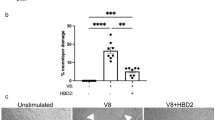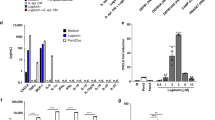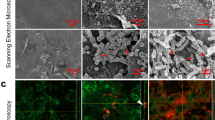Abstract
Defensins are small cationic proteins that harbor broad-spectrum microbicidal activity against bacteria, fungi and viruses. This study examines the effects on pathogens of the epidermis engineered to express human beta-defensin 3 (HBD3) to combat bacterial infections. First, we examined the localization of HBD3 in the epidermis and observed HBD3 in the intercellular spaces and lamellar bodies of the upper epidermal layers. This result showed HBD3 expressed and assembled in the outer layers of the epidermis was suspected to counter the invading microorganisms. Next, we established a keratinocyte cell line that stably expressed HBD3 and found that the culture medium showed antibacterial activity. Furthermore, we prepared an epidermal sheet of these cells with the HBD3 gene and grafted this onto a dermal wound on a nude rat. The HBD3 engineered epidermis demonstrated significant antimicrobial activity. Skin ulcers without epidermis are constantly exposed to invading microorganisms. Biopsy samples of re-epithelizing epidermis from patients with skin ulcers were collected, and HBD3 mRNA level measured in the epidermis. The epidermal samples from the ulcer skin expressed 2.5 times higher levels of HBD3 transcript than those in the control skin. These results, taken together, indicate that the therapeutic introduction of the HBD3 gene into somatic cells may provide a new gene therapy strategy for intractable infectious diseases.
This is a preview of subscription content, access via your institution
Access options
Subscribe to this journal
Receive 12 print issues and online access
$259.00 per year
only $21.58 per issue
Buy this article
- Purchase on Springer Link
- Instant access to full article PDF
Prices may be subject to local taxes which are calculated during checkout




Similar content being viewed by others
References
Ganz T, Selsted ME, Lehrer RI . Defensins. Eur J Haematol 1990; 44: 1–8.
Lehrer RI, Lichtenstein AK, Ganz T . Defensins: antimicrobial and cytotoxic peptides of mammalian cells. Annu Rev Immunol 1993; 11: 105–128.
Bensch KW et al. hBD-1: a novel beta-defensin from human plasma. FEBS Lett 1995; 368: 331–335.
Harder J, Bartels J, Christophers E, Schroder JM . A peptide antibiotic from human skin. Nature 1997; 387: 861.
Harder J, Bartels J, Christophers E, Schroder JM . Isolation and characterization of human beta-defensin-3, a novel human inducible peptide antibiotic. J Biol Chem 2001; 276: 5707–5713.
Garcia JR et al. Human beta-defensin 4: a novel inducible peptide with a specific salt-sensitive spectrum of antimicrobial activity. FASEB J 2001; 15: 1819–1821.
Valore EV et al. Human beta-defensin-1: an antimicrobial peptide of urogenital tissues. J Clin Invest 1998; 101: 1633–1642.
Harder J et al. Mucoid Pseudomonas aeruginosa, TNF-alpha, and IL-1beta, but not IL-6, induce human beta-defensin-2 in respiratory epithelia. Am J Respir Cell Mol Biol 2000; 22: 714–721.
Bals R, Weiner DJ, Meegalla RL, Wilson JM . Transfer of a cathelicidin peptide antibiotic gene restores bacterial killing in a cystic fibrosis xenograft model. J Clin Invest 1999; 103: 1113–1117.
Nikol S et al. Needle injection catheter delivery of the gene for an antibacterial agent inhibits neointimal formation. Gene Therapy 1999; 6: 737–748.
Huang GT et al. A model for antimicrobial gene therapy: demonstration of human beta-defensin 2 antimicrobial activities in vivo. Hum Gene Ther 2002; 13: 2017–2025.
Horikoshi T et al. Role of endogeneous cathepsin D-like and chymotrypsin-like proteolysis in human epidermal desquamation. Br J Dermatol 1999; 141: 453–459.
Ishida-Yamamoto A et al. Epidermal lamellar granules transport different cargoes as distinct aggregates. J Invest Dermatol 2004; 122: 1137–1144.
Oren A, Ganz T, Liu L, Meerloo T . In human epidermis, beta-defensin 2 is packaged in lamellar bodies. Exp Mol Pathol 2003; 74: 180–182.
Norlen L . Skin barrier structure and function: the single gel phase model. J Invest Dermatol 2001; 117: 830–836.
Fellermann K, Wehkamp J, Stange EF . Antimicrobial peptides in the skin. N Engl J Med 2003; 348: 361–363.
Simizu H, McDonald JN, Kennedy AR, Eady RA . Demonstration of intra- and extracellular localization of bullous pemphigoid antigen using cryofixation and freeze substitution for embedding immunoelectron microscopy. Arch Dermatol Res 1989; 106: 443–448.
Boukamp P et al. Normal keratinization in a spontaneously immortalized aneuploid human keratinocyte cell line. J Cell Biol 1988; 106: 761–771.
Sawamura D et al. Induction of keratinocyte proliferation and lymphocytic infiltration by in vivo introduction of the IL-6 gene into keratinocytes and possibility of keratinocyte gene therapy for inflammatory skin diseases using IL-6 mutant genes. J Immunol 1998; 161: 5633–5639.
Author information
Authors and Affiliations
Rights and permissions
About this article
Cite this article
Sawamura, D., Goto, M., Shibaki, A. et al. Beta defensin-3 engineered epidermis shows highly protective effect for bacterial infection. Gene Ther 12, 857–861 (2005). https://doi.org/10.1038/sj.gt.3302472
Received:
Accepted:
Published:
Issue Date:
DOI: https://doi.org/10.1038/sj.gt.3302472
Keywords
This article is cited by
-
Tape stripping method is useful for the quantification of antimicrobial peptides on the human skin surface including the stratum corneum
Scientific Reports (2020)
-
Bombyx mori gloverin A2 alleviates enterotoxigenic Escherichia coli-induced inflammation and intestinal mucosa disruption
Antimicrobial Resistance & Infection Control (2019)
-
Defining MC1R Regulation in Human Melanocytes by Its Agonist α-Melanocortin and Antagonists Agouti Signaling Protein and β-Defensin 3
Journal of Investigative Dermatology (2012)
-
Patented natural avocado sugar modulates the HBD-2 and HBD-3 expression in human keratinocytes through Toll-like receptor-2 and ERK/MAPK activation
Archives of Dermatological Research (2012)
-
Impact of acute stress on antimicrobial polypeptides mRNA copy number in several tissues of marine sea bass (Dicentrarchus labrax)
BMC Immunology (2011)



